Imported Fire Ants in Kentucky
ENTFACT-469: Imported Fire Ants in Kentucky | Download PDF
Jonathan L. Larson, Zach DeVries, and Ric Bessin, Extension Specialists
and Joe Collins, Office of the State Entomologist
Fast Facts
- Imported fire ants (IFA) are spreading into Kentucky. Since 2000, the Land Between the Lakes area has had isolated incidences of fire ants. In 2022, IFA were found in southern Kentucky, specifically McCreary, Whitley, and Knox counties.
- Fire ants are a significant health concern and can be agricultural pests. Worker ants will vigorously defend their nest, often resulting in dozens of stings on people and animals. The sting site will burn and become inflamed. Anaphylaxis is possible in sensitive people.
- As fire ants become more widespread in Eastern Kentucky, quarantines could be introduced that might restrict the movement of nursery goods, soil, heavy machinery, and hay.
- You can report a suspicious ant mound or a stinging event to the University of Kentucky Entomology Department through email, reportapest@uky.edu, or on Facebook at Kentucky Bugs.
Imported Fire Ant Biology
Imported fire ants (IFA or just fire ants) are social insects that produce colonies which house thousands of ants. In the colony there is a division of labor. The majority of the work is done by sterile female worker ants. These ants make up the bulk of the nest’s population. There are also queen ants, responsible for egg laying that will result in more workers. IFA colonies can be single queen colonies or multi-queen colonies. Single queen nests are more “territorial” and will defend their area from other ant colonies. Multi-queen colonies are more gregarious which results in more colonies per acre. Aside from queens and workers, there can also winged reproductive queens and males in fire ant nests. Reproduction can occur when outdoor temperatures are 70-95°F and may be more likely to occur after a rain event. New queens may fly as far as 2-3 miles from the home colony to begin their new nest.
There are two species of imported fire ants: red imported fire ant and black imported fire ant. IFA can also hybridize. Ants progress through complete metamorphosis. Inside the nest you would find small white eggs, grub like larvae, and pupae as well as adults.
Fire ants prefer to nest in open, sunny areas often with large southern exposures. Their mounds can be commonly found in lawns, parks, and sports fields. Pastures, roadsides, meadows, and agriculture fields can also house ants.
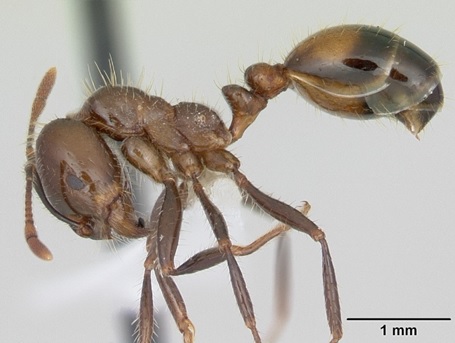
Figure 1: A black imported fire ant worker, Photo by April Noble, Antweb.org.
The History of Fire ants in Kentucky
Imported fire ants have been a reoccurring problem in the state of Kentucky since the year 2000. They were first found in the Land Between the Lakes area in western Kentucky. Those mounds have been managed and eradicated and there has not been any spread out from there in the last 20 years.
Unfortunately, in 2022, reports of fire ant mounds began to arrive from McCreary County in southeastern Kentucky. Subsequent inspections over the course of a few months revealed that fire ants are also present in Whitley and Knox Counties. These counties are home to numerous nests, most associated with roadsides and construction sites but they have been found on private property as well.
It is difficult to know exactly how they entered Kentucky. Fire ants can move naturally with wind currents. It is also possible they were introduced with the movement of material like pine straw, mulch/compost, or possibly soil. Additionally, fire ants can be inadvertently moved in hay bales or even heavy machinery such as earth moving equipment and forestry equipment. They can also float as an ant “life raft” when there are floods. It is thought that this waterborne method may be how they arrived in western Kentucky. Once introduced, the colonies have gotten larger and eventually reproduced by sending out new queens to start their own nests.
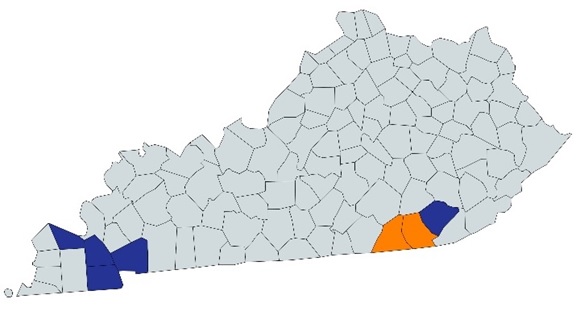
Figure 2: As of 2022, counties highlighted in blue have had confirmed IFA mounds that have been managed. Counties in orange have ongoing infestations.
Fire Ant Identification
IFA queens are around 3/8th inch long and are dark red or brown depending on the species. They are initially winged until they start their nest, at which point they will lose their wings. IFA workers can be a range of sizes within a nest, from 1/16th to 1/4th inch long. They will be the same color as the queen of the nest, dark red to dark brown. Both queens and workers have elbowed antennae. Male fire ants are similar in size to queens and also have wings. However, they will be darker in color, have smaller heads, and straight antennae.
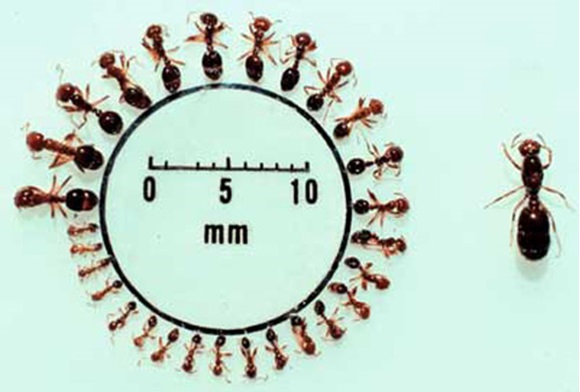
Figure 3: Fire ant workers are not a standard size. All the ants around the circle are workers, a queen is on the right for reference. Photo by Sanford D. Porter, USDA
Conclusive identification of a fire ant requires the use of magnification to count the segments of the antenna, look for spines on the thorax, and to count the nodes of the suspect ant. IFA have ten segmented antennae, with the last two resembling a “club”, no spines on the thorax, and two nodes on their “waist”. This identification is best done by an entomologist, and you can submit samples to us through your local county Extension office for identification.

Figure 4: When a fire ant nest is disturbed, worker ants will rapidly appear. This behavior is described as “boiling out”. Photo by Barry Rice, sarracenia.com, Bugwood.org
Fire ant mounds can help with field identification. IFA mounds in KY can be as large as 18-24 inches tall and up to 2 feet in width, however newly formed mounds are much smaller. The mound is made up of soil the ants have dug from below and there is no noticeable entrance hole to the mound. The mounds occur in open sunny locations where grass and weeds are sparce and may be built at the bases of trees, logs, fence posts, outdoor electric/irrigation housings, or up against structures. When the nest is disturbed, fire ants will “boil out” of the mound. This behavior is very distinctive, more associated with this species than with other more common ants in Kentucky.
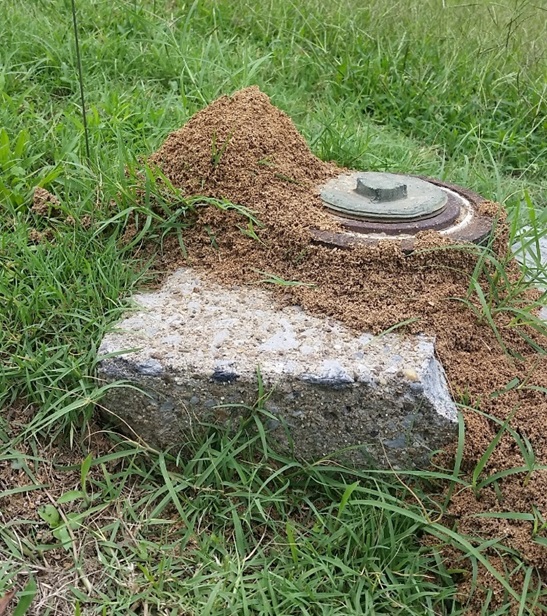
Figure 5: IFA mounds can be found near human made objects. Photo by Joe Collins.
Issues Associated with Imported Fire Ants
IFA interfere with outdoor recreation, impact agriculture, and are harmful for domesticated animals and wildlife. The chief issue with fire ants is the painful and dangerous sting they can inflict. When workers boil from their nest, they will climb up the appendages of humans or animals that have disturbed the colony. When the intruder moves or tries to remove the ants, they will release an alarm pheromone. This will induce the ants to bite as well as sting, seemingly doing so in unison. Each individual ant can sting multiple times.
The sting is painful, often described as causing a burning sensation at the sting site. The burning will gradually fade though the sting site may continue to hurt for hours after the incident. Gradually, the sting site will redden and there could be the development of an almost pimple like structure. Some people may be more sensitive to the venom than others. This can lead to anaphylaxis. Individuals with a sensitivity to other insect stings should take care to avoid fire ants and be sure to carry their epinephrine with them.
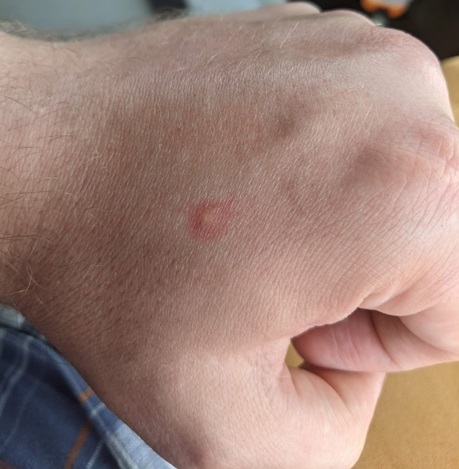
Figure 6: Fire ants bite and sting simultaneously. Each ant can sting multiple times. Stings inflame the skin and will gradually harden and form a white pustule like top. Photo by Jonathan L. Larson.
Beyond stinging humans, fire ants can have mixed effects on the areas they invade. Sometimes, IFA colonies cause issues in agriculture by feeding on seedling plants, chewing through irrigation tubing, and harming animals. Conversely, they provide significant biological control, often suppressing pest caterpillars, fleas, and even ticks.
Aside from direct damage to the environment, when fire ants are discovered in a new area, there is the possibility a quarantine of the county may be enacted. This would lead to restrictions in the movement of certain goods out of quarantined counties. Multiple industries in Kentucky could be impacted by such quarantines, including but not limited to logging, plant nurseries, hay transportation, and construction.
Management and Reporting
In other southeastern states, fire ant management is accomplished using ant baits, broadcast insecticide applications, or direct insecticide application to mounds. Thus far in Kentucky, baiting has been the main strategy used against IFA. Fire ant baits are granules that are applied on and near the mound. The granules are then taken inside by workers to feed to the colony. Over an extended period of time, the bait will be fed to members of the colony. This is a preferred method of management as the bait’s effects are specific to ants and there is a reduction in insecticide residue present in the environment, though the time needed for success requires patience.
Broadcast applications of areas infested with ants can be done with bifenthrin, gamma-cyhalothrin, cyfluthrin, fipronil, or permethrin insecticides. But not all products can be used at all types of sites. Depending on the active ingredient, the application can be done with liquid or granule products. These applications may last multiple months but rely on ants coming into contact with treated soil. Applications made directly to mounds may be liquid applications or dry applications as dusts or granules. Liquid products include permethrin, bifenthrin, and spinosad. Dusts include acephate, cyfluthrin, and deltamethrin and granules include cypermethrin and bifenthrin. Always read and follow label directions before using a pesticide product.
While there are insecticides available to homeowners that may control imported fire ants, the Department of Entomology and the Office of the State Entomologist would prefer that homeowners who fear they have a fire ant infestation report it to us or their county extension agent rather than treat it themselves.
If you have found a suspect ant or ant mound on your property, or if you see something while outside on public land, please report it so that the Office of the State Entomologist can evaluate and identify. To best facilitate verification of a suspect fire ant mound, please include a collected ant worker, frozen and then preserved in a hard plastic container or a photograph taken of the suspect mound to help with this process. When making your report, it is vital that you supply GPS coordinates or at least an address. Without this info, we will not know where to go and we won’t be able to keep track of fire ants in the state. Reporting can be done in several ways:
Email:
Or you can reach out to the department through social media-
Kentucky Bugs on Facebook
https://www.facebook.com/Kentucky-Bugs-262237810453730/
You can also consult with your local county Extension office for help in reaching us as well.
Sources
- Texas A&M Fire Ant Research and Management Project
https://fireant.tamu.edu/ - Mississippi State Extension
http://extension.msstate.edu/insects/fire-ants - North Carolina State Extension
https://entomology.ces.ncsu.edu/red-imported-fire-ant/ - Alabama Cooperative Extension Service
https://www.aces.edu/blog/tag/fire-ants/
02/23 (Issued)
CAUTION! Pesticide recommendations in this publication are registered for use in Kentucky, USA ONLY! The use of some products may not be legal in your state or country. Please check with your local county agent or regulatory official before using any pesticide mentioned in this publication. Of course, ALWAYS READ AND FOLLOW LABEL DIRECTIONS FOR SAFE USE OF ANY PESTICIDE!
Images: University of Kentucky Entomology unless otherwise indicated
